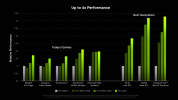Actually, they have already shown the 4070 and 4060Ti cards, they just put the 4080 sticker on both of them. I mean just look at the die size and TFLOP difference to the 4090 and compare them to previous gens.
Maybe it makes more sense if you look at the 90 as higher specced than usual, so the lower cards appear somewhat downgraded only in relation to that, but not really if we compare to prev gen?
However, i notice that the biggest cards currently seem to have the best price / value ratio in general, also looking at how prices of Ampere / RDNA2 go down.
Bigger cards decrease faster. In other words: Little demand. It's interesting to see how desparate NV tires to change this. They even try to build up a proprietary modding community, driven from machine learning lacking any inspiration, sigh.
let's hope AMD is not following the same trend and is using the opportunity.
Would be too good to be true.
They always use the worng strategy at the wrong time.
AMD has offered more power at lower prices before, but it did not help with market share. Problem was that devs did not utilize high compute power but focused on just rasterization. This could not saturate GCN, so benchmarks looked bad.
Now they are tired of selling at lower price, although at current times i'm sure it would help with market share. Problem is that devs again just focus on raster and now RT, and we'll see how AMD improves on the latter.
But maybe it's exactly this problem, plus Intels aggressive pricing which makes them change their mind indeed.
If people buy this like crazy, it just tells me they are very bad at math or just plain stupid
They are used to the idea NV alone gave us everything, and all innovation and progress came from them.
Now they stand loyal to their captain, nip champaigne and congratulate to the great achievements of RT and ML, and stand proud on the biggest ship ever made. Unsinkable, with golden ornaments, and mighty horse power below.
Of course this has some cost. But obviously it's woth it, they are sure.
So they pay to stay aboard, and ignore the little iceberg in front.
I know, i know. It's just that under such circumstances, technical discussion is not really possible. Because even math becomes wrong if it disagrees with convictions so deeply founded. ; )

